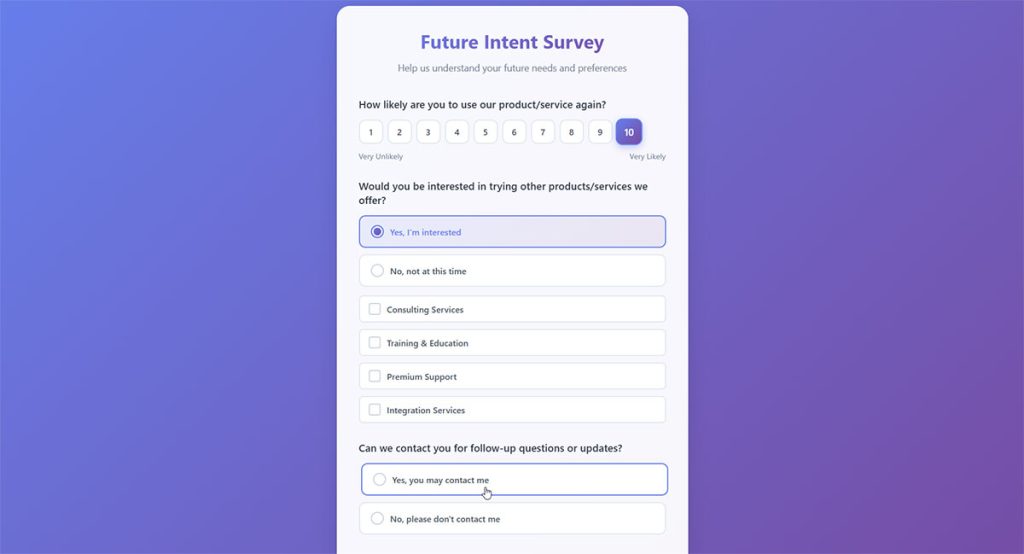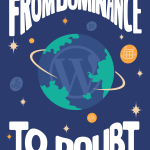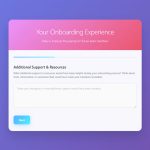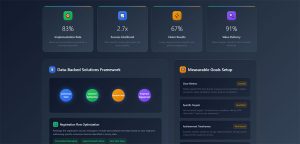You send a survey. Half your audience ignores it. The other half quits halfway through. Sound familiar? Survey fatigue is killing your response rates and destroying data quality. When participants…
Table of Contents
Crafting the right feedback survey questions can transform raw opinions into actionable insights that drive real business improvements.
Whether you’re measuring customer satisfaction, tracking employee engagement, or collecting user feedback, the quality of your questions determines the value of your responses. Poor question design leads to response bias, low completion rates, and unreliable data.
This article shows you how to create survey questions that actually get answered. You’ll learn the difference between open-ended questions and rating scales, discover when to use Net Promoter Score measurements, and understand how question types affect response patterns.
We’ll cover:
- Essential question formats for different feedback goals
- Common mistakes that skew survey results
- Proven techniques for higher response rates
- Ready-to-use templates for customer, employee, and user surveys
Feedback Survey Questions
Overall Experience

Overall Experience Rating
Question: How would you rate your overall experience with [product/service/event]?
Type: Multiple Choice (1–5 scale from “Very poor” to “Excellent”)
Purpose: Provides a comprehensive snapshot of customer satisfaction and serves as a key performance indicator for overall business health.
When to Ask: At the end of any customer interaction, purchase, or service completion.
Net Promoter Score
Question: How likely are you to recommend us to a friend or colleague?
Type: Scale (0–10 where 0 is “Not at all likely” and 10 is “Extremely likely”)
Purpose: Measures customer loyalty and predicts business growth by identifying promoters, passives, and detractors.
When to Ask: After significant interactions, purchases, or periodically for ongoing relationships.
Overall Satisfaction Level
Question: What is your overall satisfaction level on a scale of 1-10?
Type: Scale (1–10 where 1 is “Completely dissatisfied” and 10 is “Completely satisfied”)
Purpose: Quantifies general contentment and helps track satisfaction trends over time.
When to Ask: During regular check-ins, after service completion, or in periodic customer surveys.
Product/Service Quality
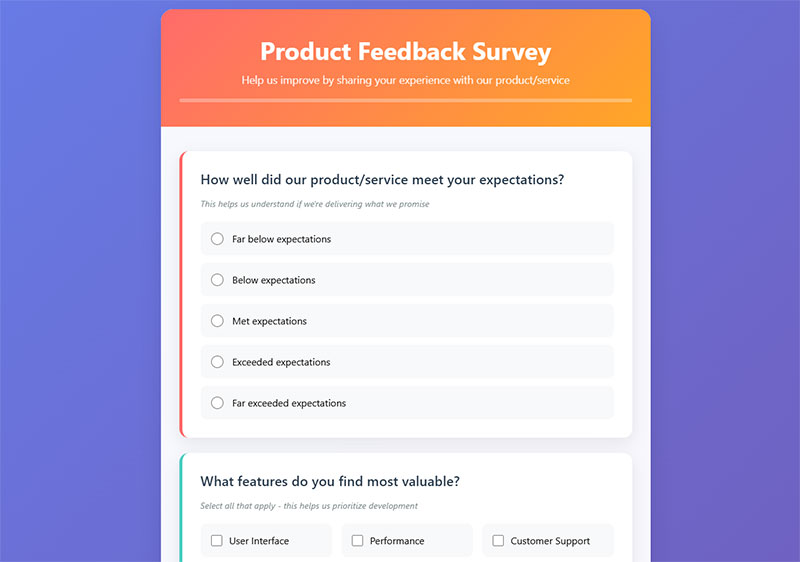
Expectation Alignment
Question: How well did our product/service meet your expectations?
Type: Multiple Choice (5-point scale from “Far below expectations” to “Far exceeded expectations”)
Purpose: Identifies gaps between customer expectations and actual delivery, helping improve marketing messaging and product development.
When to Ask: Shortly after purchase or first use of the product/service.
Most Valuable Features
Question: What features do you find most valuable?
Type: Multiple Choice (list of features) or Open-ended
Purpose: Identifies key value drivers to emphasize in marketing and prioritize in development efforts.
When to Ask: After users have had sufficient time to explore and use various features.
Least Useful Features
Question: What features do you find least useful or unnecessary?
Type: Multiple Choice (list of features) or Open-ended
Purpose: Helps streamline offerings, reduce complexity, and reallocate development resources to more valuable features.
When to Ask: During comprehensive product reviews or when considering feature updates.
Competitive Quality Comparison
Question: How would you rate the quality compared to similar products/services?
Type: Multiple Choice (5-point scale from “Much worse” to “Much better”)
Purpose: Benchmarks competitive positioning and identifies areas where you lead or lag behind competitors.
When to Ask: When customers have experience with competitors or during market research initiatives.
Issues and Problems
Question: Were there any issues or problems you encountered?
Type: Yes/No followed by open-ended explanation if “Yes”
Purpose: Identifies pain points, bugs, or service failures that need immediate attention and resolution.
When to Ask: Immediately after problem resolution or during regular quality assessments.
Customer Service
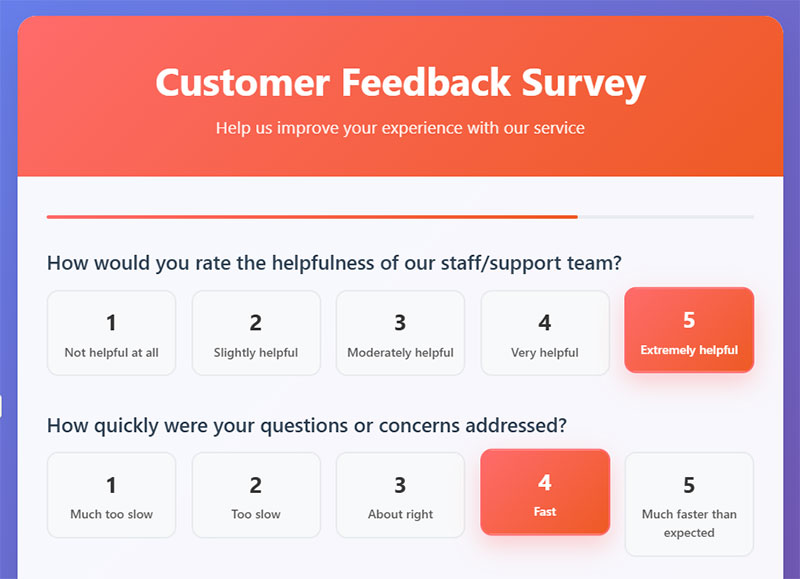
Staff Helpfulness Rating
Question: How would you rate the helpfulness of our staff/support team?
Type: Multiple Choice (1–5 scale from “Not helpful at all” to “Extremely helpful”)
Purpose: Evaluates team performance and identifies training needs or recognition opportunities.
When to Ask: Immediately after any customer service interaction or support request.
Response Time Satisfaction
Question: How quickly were your questions or concerns addressed?
Type: Multiple Choice (5-point scale from “Much too slow” to “Much faster than expected”)
Purpose: Measures efficiency of support processes and helps set appropriate response time expectations.
When to Ask: After support tickets are resolved or customer inquiries are answered.
Staff Knowledge Assessment
Question: Did our team demonstrate good knowledge of the product/service?
Type: Multiple Choice (1–5 scale from “Very poor knowledge” to “Excellent knowledge”)
Purpose: Identifies knowledge gaps in staff training and ensures customers receive accurate information.
When to Ask: Following technical support interactions or product consultations.
Communication Professionalism
Question: How professional and courteous was our communication?
Type: Multiple Choice (1–5 scale from “Very unprofessional” to “Very professional”)
Purpose: Maintains service quality standards and identifies coaching opportunities for customer-facing staff.
When to Ask: After any direct communication with customers, especially for complaint resolution.
Usability and Convenience
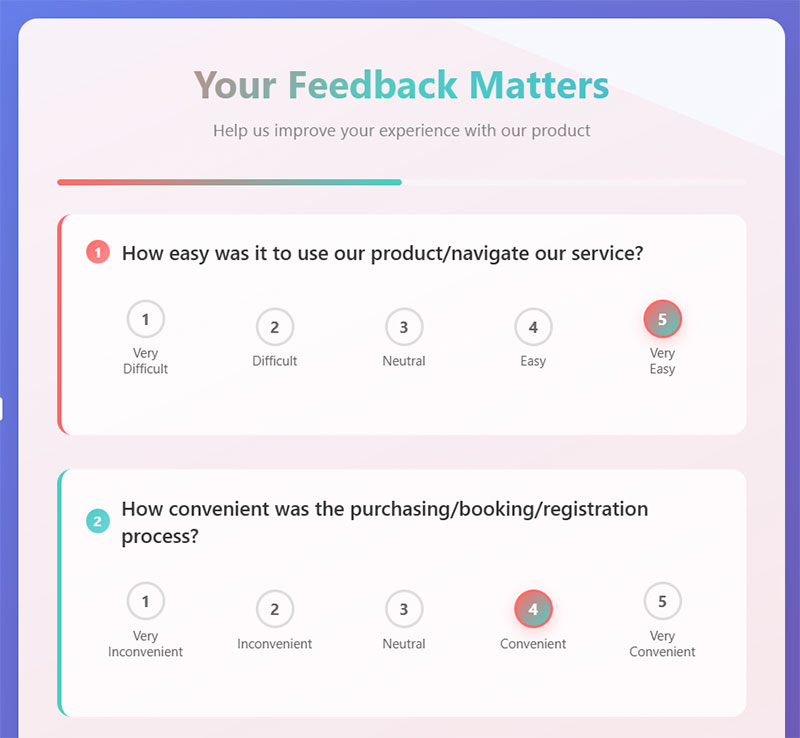
Ease of Use Rating
Question: How easy was it to use our product/navigate our service?
Type: Multiple Choice (1–5 scale from “Very difficult” to “Very easy”)
Purpose: Identifies usability barriers and guides user experience improvements.
When to Ask: During onboarding processes or after initial product exploration.
Process Convenience
Question: How convenient was the purchasing/booking/registration process?
Type: Multiple Choice (1–5 scale from “Very inconvenient” to “Very convenient”)
Purpose: Optimizes conversion funnels and reduces abandonment rates by identifying friction points.
When to Ask: Immediately after completing any transactional process.
Usability Improvement Suggestions
Question: What would make our product/service easier to use?
Type: Open-ended
Purpose: Gathers specific improvement ideas directly from users to guide UX/UI enhancements.
When to Ask: During user testing sessions or comprehensive experience surveys.
Technical Difficulties
Question: Did you encounter any technical difficulties?
Type: Yes/No followed by detailed description if “Yes”
Purpose: Identifies bugs, system issues, or technical barriers that impact user experience.
When to Ask: After system interactions or when troubleshooting user problems.
Value and Pricing
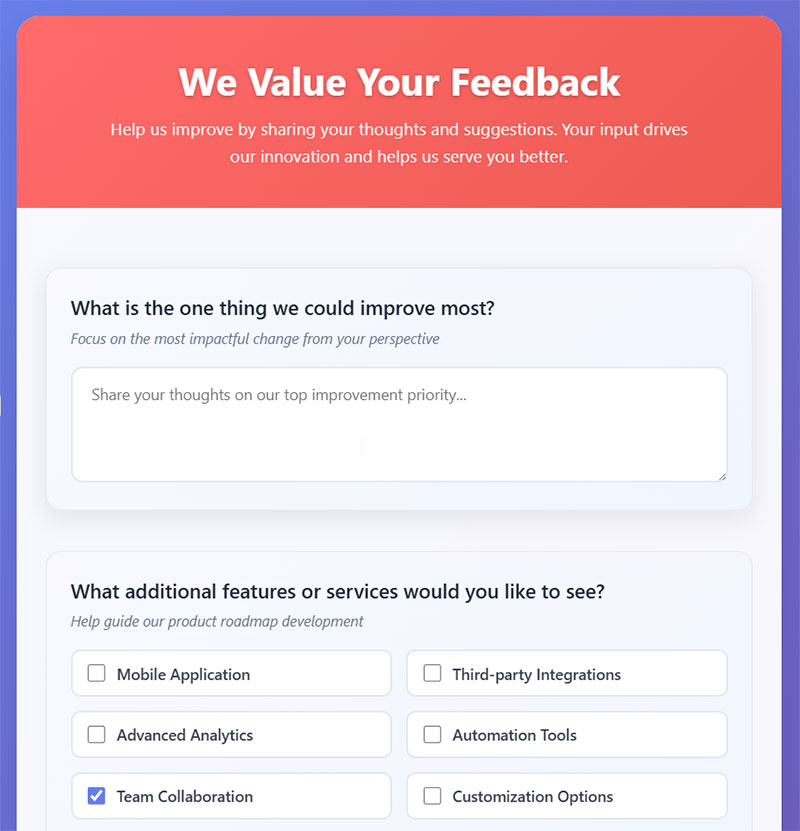
Value for Money Assessment
Question: Do you feel you received good value for money?
Type: Multiple Choice (1–5 scale from “Very poor value” to “Excellent value”)
Purpose: Evaluates pricing strategy effectiveness and identifies opportunities for value communication or pricing adjustments.
When to Ask: After purchase completion or during renewal discussions.
Competitive Price Comparison
Question: How do our prices compare to competitors?
Type: Multiple Choice (5-point scale from “Much more expensive” to “Much less expensive”)
Purpose: Benchmarks pricing position in the market and informs competitive pricing strategies.
When to Ask: During market research or when customers are evaluating alternatives.
Pricing Fairness Perception
Question: Would you consider our pricing fair and reasonable?
Type: Yes/No with optional explanation
Purpose: Assesses price sensitivity and helps justify pricing to stakeholders and customers.
When to Ask: When introducing new pricing or addressing pricing objections.
Improvement and Suggestions
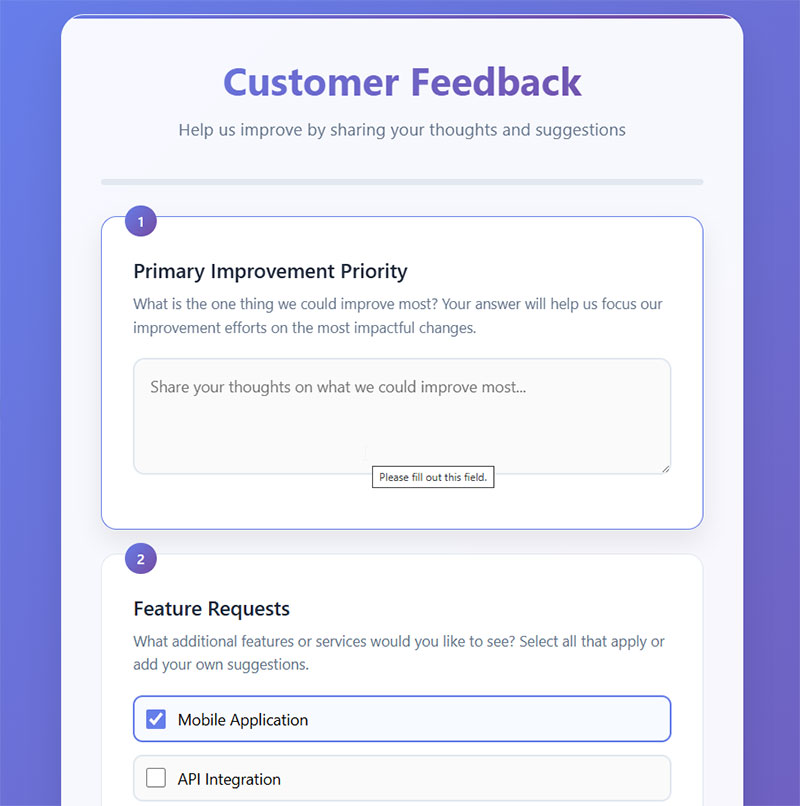
Primary Improvement Priority
Question: What is the one thing we could improve most?
Type: Open-ended
Purpose: Focuses improvement efforts on the most impactful changes from the customer perspective.
When to Ask: During comprehensive reviews or when planning major updates.
Feature Requests
Question: What additional features or services would you like to see?
Type: Open-ended or Multiple Choice (list of potential features)
Purpose: Guides product roadmap development and identifies new revenue opportunities.
When to Ask: During strategic planning periods or when engaging power users.
Elimination Recommendations
Question: Is there anything we should stop doing?
Type: Open-ended
Purpose: Identifies wasteful practices, annoying features, or processes that detract from customer experience.
When to Ask: During efficiency reviews or when streamlining operations.
Increased Usage Drivers
Question: What would make you more likely to use our product/service again?
Type: Open-ended
Purpose: Identifies retention drivers and helps develop customer loyalty strategies.
When to Ask: With at-risk customers or during retention campaigns.
Demographics and Context

Usage Duration
Question: How long have you been using our product/service?
Type: Multiple Choice (time ranges like “Less than 1 month,” “1-6 months,” etc.)
Purpose: Segments feedback by customer maturity and identifies patterns in the customer journey.
When to Ask: In any comprehensive survey to provide context for other responses.
Usage Frequency
Question: How frequently do you use it?
Type: Multiple Choice (frequency options like “Daily,” “Weekly,” “Monthly,” etc.)
Purpose: Understands engagement levels and identifies opportunities to increase usage.
When to Ask: During regular check-ins or when analyzing user behavior patterns.
Primary Use Case
Question: What is your primary use case or reason for choosing us?
Type: Multiple Choice (list of common use cases) or Open-ended
Purpose: Identifies core value propositions and helps tailor marketing messages to different customer segments.
When to Ask: During onboarding or when developing customer personas.
Discovery Channel
Question: How did you first hear about us?
Type: Multiple Choice (list of marketing channels and referral sources)
Purpose: Measures marketing channel effectiveness and optimizes customer acquisition strategies.
When to Ask: During initial interactions or customer onboarding processes.
Open-Ended Questions
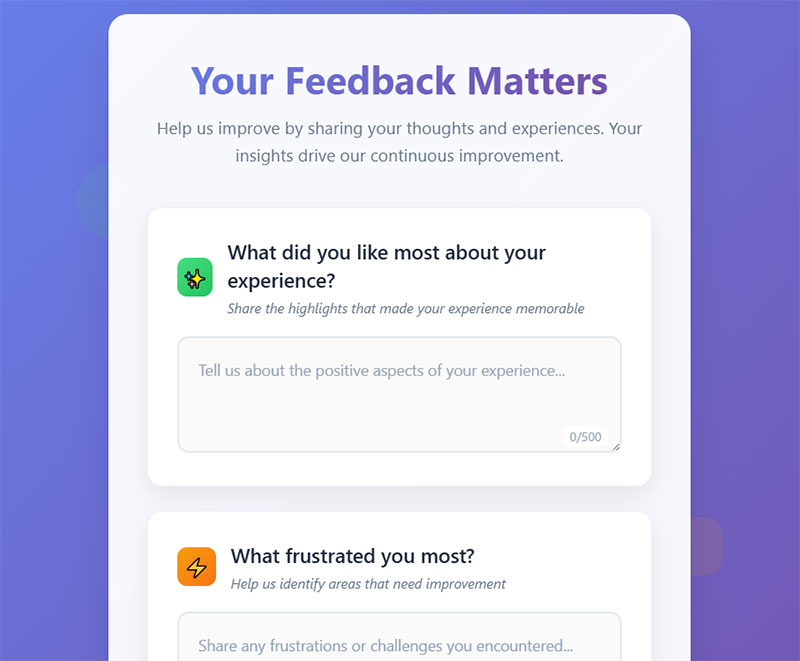
Positive Experience Highlights
Question: What did you like most about your experience?
Type: Open-ended
Purpose: Identifies strengths to maintain and amplify, and provides content for testimonials and case studies.
When to Ask: After positive interactions or successful project completions.
Frustration Points
Question: What frustrated you most?
Type: Open-ended
Purpose: Uncovers emotional pain points that quantitative metrics might miss, enabling targeted improvements.
When to Ask: After problem resolution or during comprehensive experience reviews.
Additional Feedback
Question: Any additional comments or suggestions?
Type: Open-ended
Purpose: Captures unexpected insights and gives customers a voice for concerns not covered by structured questions.
When to Ask: At the end of any survey to ensure comprehensive feedback collection.
Future Intent

Repeat Usage Likelihood
Question: How likely are you to use our product/service again?
Type: Scale (1–10 where 1 is “Very unlikely” and 10 is “Very likely”)
Purpose: Predicts customer retention and identifies at-risk accounts requiring intervention.
When to Ask: After project completion or during regular relationship reviews.
Cross-Selling Interest
Question: Would you be interested in trying other products/services we offer?
Type: Yes/No with optional specification of interest areas
Purpose: Identifies upselling and cross-selling opportunities to increase customer lifetime value.
When to Ask: With satisfied customers or during account expansion discussions.
Follow-up Permission
Question: Can we contact you for follow-up questions or updates?
Type: Yes/No with preferred contact method
Purpose: Builds permission for ongoing communication and enables deeper relationship development.
When to Ask: At the end of surveys or after positive interactions to maintain engagement.
FAQ on Feedback Survey Questions
What are the best question types for customer satisfaction surveys?
Use Net Promoter Score questions, Likert scale ratings, and targeted open-ended questions. Mix multiple choice options with descriptive text fields. Balance quantitative data collection with qualitative feedback. Choose question types that match your survey goals and response analysis capabilities.
How many questions should a feedback survey contain?
Keep surveys under 10 questions for maximum response rates. Brief surveys get 40% higher completion rates than lengthy questionnaires. Focus on essential data collection points. Eliminate demographic questions unless critical. Time your surveys to take under 5 minutes.
When should I use open-ended versus closed-ended questions?
Open-ended questions reveal unexpected insights and customer pain points. Use them sparingly for deeper context. Closed-ended questions provide measurable data and faster analysis. Most effective surveys combine 20% open questions with 80% structured response options.
How do I avoid survey bias in my questions?
Write neutral questions without leading language. Randomize answer choices in multiple choice surveys. Test questions with small groups first. Avoid double-barreled questions asking two things at once. Keep rating scales consistent throughout your questionnaire design.
What’s the ideal timing for sending feedback surveys?
Send transactional surveys within 24 hours of customer interactions. Employee engagement questions work best quarterly. Post-purchase feedback performs well 3-7 days after delivery. Consider types of survey questions based on your timing needs.
How can I improve my survey response rates?
Personalize survey invitations with recipient names. Offer survey incentives when appropriate. Send reminder emails after 48 hours. Optimize surveys for mobile devices. Use clear subject lines explaining the survey’s purpose and estimated completion time.
Should feedback surveys be anonymous?
Anonymous surveys generate more honest responses for sensitive topics. Employee feedback and performance reviews benefit from anonymity. Customer satisfaction surveys often work better with identification for follow-up. Balance privacy needs with data collection requirements.
What rating scales work best for feedback questions?
Five-point Likert scales balance simplicity with nuance. Seven-point scales offer more granularity for complex evaluations. Avoid even-numbered scales that lack neutral options. Keep scale formatting consistent across all survey form templates for accurate response analysis.
How do I analyze survey responses effectively?
Use cross-tabulation for demographic comparisons. Calculate Net Promoter Scores for loyalty metrics. Track response patterns over time. Combine quantitative scoring with qualitative comment analysis. Export data to specialized survey analytics platforms for deeper insights.
What mistakes should I avoid when creating feedback surveys?
Don’t use jargon or technical terms respondents won’t understand. Avoid mandatory questions that force dishonest answers. Skip double negatives that confuse participants. Test form accessibility across devices. Never make surveys longer than absolutely necessary.
Conclusion
Mastering feedback survey questions requires balancing science with strategy. The right combination of question types, survey methodology, and response collection methods transforms basic data gathering into powerful customer insights.
Successful surveys start with clear objectives. Whether you’re measuring employee engagement, tracking customer satisfaction, or conducting market research, your questions must align with specific business goals. Remember these key principles:
- Test your questionnaire design with a small sample first
- Monitor response patterns and completion rates
- Use survey form builders that support branching logic
- Analyze both quantitative metrics and qualitative feedback
- Iterate based on survey analytics data
Your feedback management system should evolve continuously. Track response validation metrics, adjust survey timing, and experiment with different distribution channels. The goal isn’t just collecting data. It’s building lasting feedback loops that drive meaningful improvements.
Start small. Create focused surveys that respect respondents’ time while delivering actionable insights.


